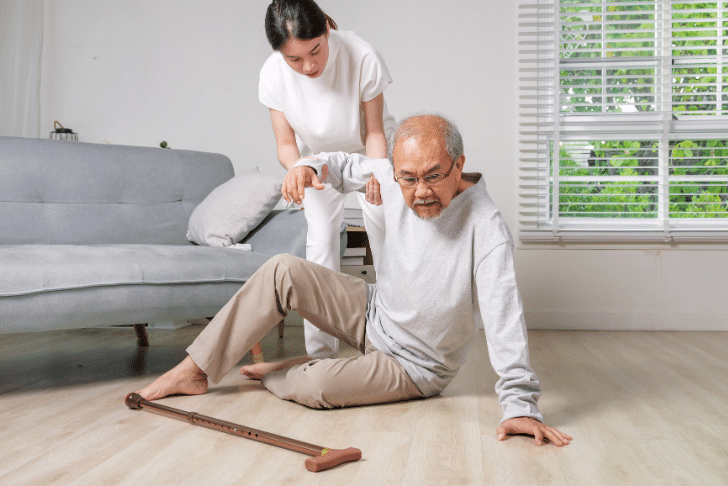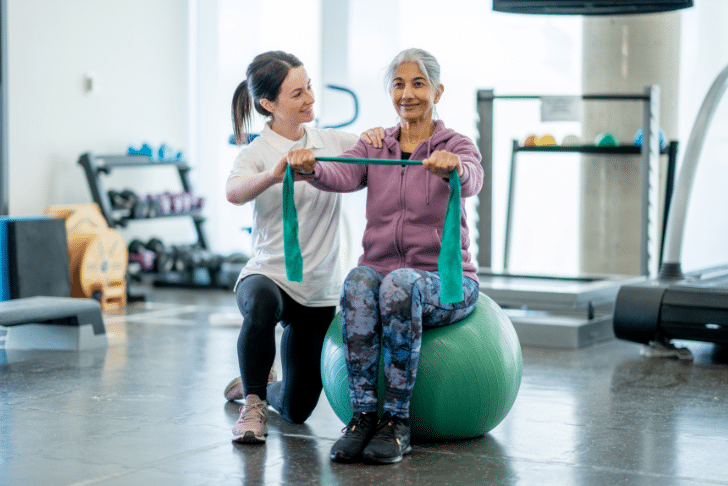Are you an older adult seeking strategies to prevent falls and injuries? This article, titled “Guidelines for Preventing Falls: Strength and Balance Exercises for Aging Adults” is your go-to resource. It provides readers with beneficial knowledge on the risk factors associated with falls in older adults, and importantly, how to mitigate them.
The article presents an array of strength and balance exercises that are proven to minimize the risk of falls. With exercises thoroughly explained and demonstrated, from the Sit-to-Stand exercise to balance exercises, older adults can feel safer and stronger in their daily activities.
Always remember, though, that you should always consult with your doctor or physical therapist for advice tailored to your health situation ensuring you get the most out of these exercises while prioritizing safety.
Understanding the Risk of Falls in Aging Adults
As we grow old, our body begins to change and our risk of accidental falls increases drastically. This becomes a significant health concern as the repercussions of fall-related injuries can be very serious for aging adults. Each year, studies show that 25% of adults aged 65 or older experience a fall. Out of these, around 3 million end up visiting emergency departments for fall injuries.
Significance of fall-related injuries in aging adults
The complications from fall injuries in aging adults extend beyond physical harm. Falls result in not only broken bones and fractures but also result in reduced independence, fear of falling again, longer recovery periods, and in some severe cases, can even be fatal.
Various factors contributing to increased fall risk
Fall risks in older adults is typically a combination of several factors. This includes balance and walking problems as vision changes and altered sensation in feet can affect balance. Also, the use of multiple medications increases fall risks, especially when an individual is taking five or more medicines. Furthermore, home hazards like dim lighting and trip hazards, as well as issues with feet and footwear, contribute to an increased risk of falls.
Common scenarios where falls often occur
Falls often occur in scenarios that might seem harmless. Places like the bathroom, when sitting down or standing up from the toilet or shower, can be particularly dangerous. Similarly, falls also frequently happen during the night in a dark bedroom when getting up quickly and tripping on the way to the bathroom.
Role of Balance and Strength Exercises in Preventing Falls
While it’s not possible to completely prevent a fall, incorporating balance and strength exercises can significantly lower the risk of falling. Activities such as squatting, standing up from a chair, and even walking can be beneficial in building strength and improving body mechanics.
Importance of balance and strength in fall prevention
These exercises significantly improve balance, increase strength and make the body more resilient. This, in turn, brings about a better sense of overall body coordination and equips the body to react quicker and more effectively when experiencing an imbalance.
How balance and strength exercises reduce fall risks
Balance and strength exercises work by incrementally training the muscles that keep us upright. This not only provides better control over movements but also leads to higher stability and equilibrium.
A discussion on the fear of falling and overcoming it
The fear of falling is common among aging adults and can germinate from the experiences of past falls. However, it’s crucial to overcome this fear as it can lead to decreased activity, resulting in weaker muscles and even greater risk of falling. Balance and strength exercises can gradually build confidence, allay fears, and encourage active participation in physical activities.

Preparations Before Starting Exercise
Before starting any new exercise regimen, it’s essential to follow some preparatory measures.
Consulting a doctor or physical therapist
Before commencing exercises aimed at lowering your fall risks, make sure to talk to your doctor or physical therapist. They can provide a thorough evaluation and guide you on the appropriate exercises suitable to your current health and fitness level.
Assessing personal health and fitness level
Perform a personal assessment of your health and fitness level. Start exercises that you feel comfortable with, then slowly increase intensity and complexity under a professional’s guidance.
Creating a safe environment for exercise
Ensure to create a safe environment for exercise, free from hazards that may cause tripping or falling. A clear, well-lit area with sturdy support, like a countertop, nearby to hold onto in case of unsteadiness, can be an ideal setup.
Guidelines for Sit-to-Stand Exercise
The Sit-to-Stand exercise is an excellent way to build leg strength and improve balance. Here’s a detailed guide on how to do it.
Overview of the Sit-to-Stand Exercise
The sit-to-stand exercise involves a simple process of sitting down and standing up from a chair. This exercise focuses on building leg strength, improves body mechanics, and enhances balance, all crucial for reducing falls.
Detailed step-by-step instructions
Start by sitting comfortably on a sturdy chair with your feet flat on the ground. Position your buttocks at the front of the seat, lean forward shifting your weight over your toes, and then slowly rise to a standing position. Make sure to have a sturdy support surface in front of you in case you feel unsteady when standing.
Tips for beginners and advanced variations
For beginners, it’s okay to use your hands for initial support. But the eventual goal is to stand up without any support. Once you get used to the routine, you can take it up a notch by holding hand weights for added resistance. Remember, feel free to adjust the exercise to fit your level of comfort.

Guidelines for Balance Exercises
Balance exercises are very efficient and effective in helping one feel steadier while standing or walking.
Introduction to balance exercises
Balance exercises primarily work by conditioning your body to be more coordinated and agile. They train your body to maintain control over your movements and help you feel less unsteady.
Descriptions and instructions for each exercise step
Starting with a position of feet shoulder-width apart, you hold this position steady for 10 seconds, slowly working your way up to 30 seconds. The next exercises involve standing with feet together and then standing on one foot, each time holding the position for 10-30 seconds.
Progressing through the stages of balance exercises
Each of these exercises should be done in the respective sequence, moving on to the next exercise only when you can confidently hold the existing one for 30 seconds with minimal swaying or support.
Safety measures when performing these exercises
While balance exercises are wonderful in improving stability, it’s crucial to take precautions while performing them. Make sure to have someone with you during these exercises or at least have a sturdy counter or handle nearby to hold onto if you lose balance.
The Importance of Regular Exercise
Incorporating balance and strength exercises in your daily routine could significantly improve your overall body function.
Recommended frequency and duration for balance and strength exercises
For best results, these exercises should be performed twice daily. Each session should ideally be about 10-30 seconds long, with multiple repetitions throughout the session.
How regular exercise contributes to fall prevention
Regular practice not only strengthens the muscles needed for balance but also significantly improves response time, coordination, and overall strength, which are essential in preventing falls.
Establishing an exercise routine
Develop a regular exercise routine by setting aside a specific time in the day and consistently following it. Slowly with practice, you’ll build momentum, form a habit, and it will become an enjoyable part of your day.

Additional Steps to Prevent Falls
Apart from exercises, multiple steps can be taken to minimize fall risks.
Understanding the role of medications in fall risks
Ensure to discuss with your doctor about your medications as the side-effects of some can increase the possibility of falls.
Home safety inspections and removal of trip hazards
Consider having a home safety inspection to identify and eliminate potential tripping hazards. Make sure your home is well-lit and has guardrails in crucial places.
Importance of reporting falls to a healthcare professional
If you fall, it’s crucial to report the incident to your doctor. Doing so can help them understand your health better and provide appropriate measures to prevent future mishap.
Involving Others in Fall Prevention Efforts
Working on fall prevention alone can sometimes be discouraging and sometimes unsafe. Involving others not only ensures security but also makes the entire process more enjoyable.
Role of family and friends in preventing falls
Your family and friends can play a vital role by providing source of support, physically and mentally, throughout this journey. Their participation in your exercise routine can boost your motivation and consistency.
Advantages of having company during exercise
Having company while exercising not only ensures safety but also encourages regular exercise practices. Moreover, sharing experiences and achievements with your loved ones could provide an enormous emotional boost.
Sharing your exercise routine and fall prevention plan with loved ones
Share your exercise routine and fall prevention plan with your loved ones. Their insights and support will not only add value to your plan but also hold you accountable in sticking to your routine.
Understanding and minimising Potential Risks
While exercises are beneficial, it’s essential to understand the potential risks and complications that can arise and to promptly address them.
Potential risks and complications of balance and strength exercises
Some potential risks include the possibility of overexertion, exercise-induced injuries or developing an imbalance condition from incorrect execution of exercises. These can be unforeseen but can be mitigated with proper professional guidance.
Addressing exercise-induced pain promptly
Should you ever experience pain from these exercises, it’s crucial to stop the exercise immediately and consult your doctor or physical therapist. The key here is to address the pain promptly and not to ignore it.
Knowing when to stop or modify an exercise
Understanding when to stop or modify an exercise is important. Remember, it’s perfectly okay to adapt exercises to your pain and comfort levels. In the end, the aim is to maintain regular physical activity and not to cause more harm.
Further Professional Support and Resources
Taking professional help does not mean weakness but stands as an intelligent decision for safety and tailored advice.
Finding a doctor or physical therapist specialising in geriatric medicine
Finding a doctor or therapist specializing in geriatric medicine can provide you with advanced guidance in fall prevention strategies. Their experience with older adults would be invaluable.
Considering physical therapy for advanced fall prevention strategies
Physical therapy can be very beneficial, especially for those who have a higher risk of falls. It provides more advanced fall prevention strategies and is often tailored to the individual’s ability.
Available health services and resources for aging adults
For older adults, several easy to access public health services and resources are available. Make sure to take advantage of these, especially those relevant to fall prevention and fitness.
In conclusion, while aging may increase fall risk, consistent strength and balance exercises, measures taken around the home, involvement of loved ones, and timely professional help can significantly reduce this risk. Always remember, it’s never too late to start with fall prevention strategies and to lead a healthy, fit, and resilient life.
